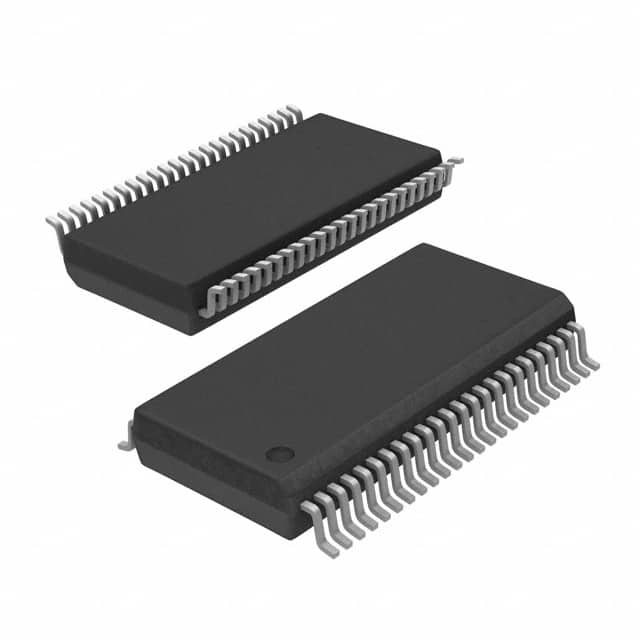SN74LVT162245DLR
Product Overview
Category
The SN74LVT162245DLR belongs to the category of integrated circuits (ICs).
Use
This IC is commonly used as a bidirectional transceiver, facilitating the exchange of data between two separate buses.
Characteristics
- Bidirectional data flow
- High-speed operation
- Low power consumption
- Wide voltage range compatibility
- ESD protection
- RoHS compliant
Package
The SN74LVT162245DLR is available in a 48-pin TSSOP package.
Essence
The essence of this product lies in its ability to enable efficient and reliable data transfer between different buses.
Packaging/Quantity
The SN74LVT162245DLR is typically packaged in reels, with each reel containing 2500 units.
Specifications
- Supply Voltage: 2.7V to 3.6V
- Input Voltage Range: 0V to VCC
- Output Voltage Range: 0V to VCC
- Operating Temperature Range: -40°C to +85°C
- Maximum Data Rate: 400Mbps
Detailed Pin Configuration
The SN74LVT162245DLR has a total of 48 pins, which are assigned specific functions. The pin configuration is as follows:
- OE (Output Enable) 1
- A1 (Data Bus A) 1
- A2 (Data Bus A) 2
- GND (Ground)
- A3 (Data Bus A) 3
- A4 (Data Bus A) 4
- A5 (Data Bus A) 5
- VCC (Power Supply)
- B1 (Data Bus B) 1
- B2 (Data Bus B) 2
- B3 (Data Bus B) 3
- B4 (Data Bus B) 4
- B5 (Data Bus B) 5
- DIR (Direction Control)
- GND (Ground)
- B6 (Data Bus B) 6
- B7 (Data Bus B) 7
- B8 (Data Bus B) 8
- B9 (Data Bus B) 9
- B10 (Data Bus B) 10
- VCC (Power Supply)
- A6 (Data Bus A) 6
- A7 (Data Bus A) 7
- A8 (Data Bus A) 8
- A9 (Data Bus A) 9
- A10 (Data Bus A) 10
- GND (Ground)
- A11 (Data Bus A) 11
- A12 (Data Bus A) 12
- A13 (Data Bus A) 13
- A14 (Data Bus A) 14
- A15 (Data Bus A) 15
- VCC (Power Supply)
- B11 (Data Bus B) 11
- B12 (Data Bus B) 12
- B13 (Data Bus B) 13
- B14 (Data Bus B) 14
- B15 (Data Bus B) 15
- GND (Ground)
- B16 (Data Bus B) 16
- B17 (Data Bus B) 17
- B18 (Data Bus B) 18
- B19 (Data Bus B) 19
- B20 (Data Bus B) 20
- VCC (Power Supply)
- OE (Output Enable) 2
- A16 (Data Bus A) 16
- A17 (Data Bus A) 17
Functional Features
The SN74LVT162245DLR offers the following functional features:
- Bidirectional data transfer between two buses
- Output enable control for tri-state operation
- Direction control for selecting the data flow direction
- ESD protection to prevent damage from electrostatic discharge
Advantages and Disadvantages
Advantages
- High-speed operation allows for efficient data transfer
- Low power consumption helps conserve energy
- Wide voltage range compatibility ensures compatibility with various systems
- ESD protection enhances reliability and durability
- RoHS compliance promotes environmental friendliness
Disadvantages
- Limited maximum data rate of 400Mbps may not be suitable for high-speed applications requiring faster data transfer
Working Principles
The SN74LVT162245DLR operates based on the principles of bidirectional data transmission. It uses a combination of input/output buffers, control logic, and direction control to facilitate the exchange of data between two separate buses. The
Senaraikan 10 soalan dan jawapan biasa yang berkaitan dengan aplikasi SN74LVT162245DLR dalam penyelesaian teknikal
Sure! Here are 10 common questions and answers related to the application of SN74LVT162245DLR:
Q: What is SN74LVT162245DLR? A: SN74LVT162245DLR is a 16-bit bus transceiver with 3-state outputs, commonly used for level shifting and signal buffering in digital systems.
Q: What is the operating voltage range of SN74LVT162245DLR? A: The operating voltage range is typically between 2.7V and 3.6V.
Q: What is the maximum data transfer rate supported by SN74LVT162245DLR? A: SN74LVT162245DLR supports a maximum data transfer rate of 400 Mbps.
Q: Can SN74LVT162245DLR be used for bidirectional communication? A: Yes, SN74LVT162245DLR can be used for bidirectional communication as it has separate input and output pins for each bit.
Q: How many channels does SN74LVT162245DLR have? A: SN74LVT162245DLR has 16 channels, allowing it to handle 16 bits of data simultaneously.
Q: What is the purpose of the 3-state outputs in SN74LVT162245DLR? A: The 3-state outputs allow the device to be disconnected from the bus, enabling multiple devices to share the same bus without interfering with each other.
Q: Can SN74LVT162245DLR handle different voltage levels on its input and output sides? A: Yes, SN74LVT162245DLR has built-in level-shifting capabilities, allowing it to interface between different voltage domains.
Q: What is the maximum output current that SN74LVT162245DLR can drive? A: SN74LVT162245DLR can typically drive up to 12 mA of output current.
Q: Is SN74LVT162245DLR compatible with other logic families? A: Yes, SN74LVT162245DLR is compatible with a wide range of logic families, including TTL, CMOS, and LVTTL.
Q: Can SN74LVT162245DLR be used in high-speed applications? A: While SN74LVT162245DLR supports relatively high data transfer rates, it may not be suitable for extremely high-speed applications due to its propagation delay characteristics.


